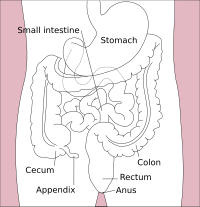
Photo from wikipedia
The long-term maintenance of an organism's homeostasis and health relies on the accurate regulation of organ-organ communication. Recently, there has been growing interest in using the Drosophila gastrointestinal tract to… Click to show full abstract
The long-term maintenance of an organism's homeostasis and health relies on the accurate regulation of organ-organ communication. Recently, there has been growing interest in using the Drosophila gastrointestinal tract to elucidate the regulatory programs that underlie the complex interactions between organs. Data obtained in this field have dramatically improved our understanding of how organ-organ communication contributes to the regulation of various aspects of the intestine, including its metabolic and physiological status. However, although research uncovering regulatory programs associated with interorgan communication has provided key insights, the underlying mechanisms have not been extensively explored. In this review, we highlight recent findings describing gut-neighbor and neighbor-neighbor communication models in adults and larvae, respectively, with a special focus on how a range of critical strategies concerning continuous interorgan communication and adjustment can be used to manipulate different aspects of biological processes. Given the high degree of similarity between the Drosophila and mammalian intestinal epithelia, it can be anticipated that further analyses of the Drosophila gastrointestinal tract will facilitate the discovery of similar mechanisms underlying organ-organ communication in other mammalian organs, such as the human intestine.
Journal Title: Frontiers in Cell and Developmental Biology
Year Published: 2017
Link to full text (if available)
Share on Social Media: Sign Up to like & get
recommendations!